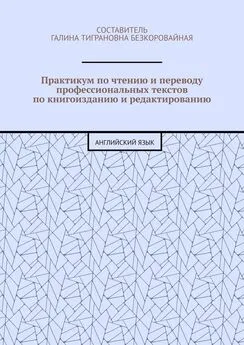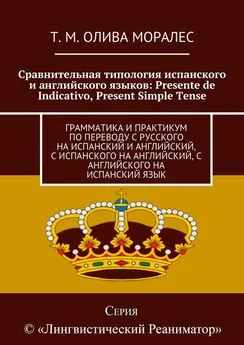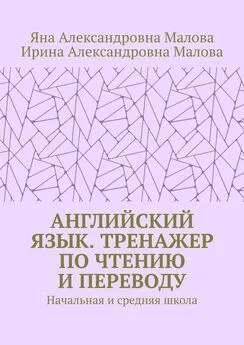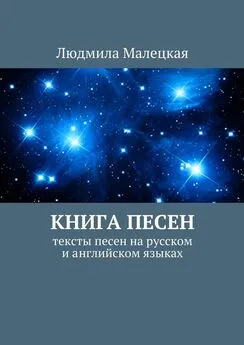Е. Казакова - Практикум по чтению и переводу профессиональных текстов по книгоизданию и редактированию. Английский язык
- Название:Практикум по чтению и переводу профессиональных текстов по книгоизданию и редактированию. Английский язык
- Автор:
- Жанр:
- Издательство:неизвестно
- Год:неизвестен
- ISBN:9785449879455
- Рейтинг:
- Избранное:Добавить в избранное
-
Отзывы:
-
Ваша оценка:
Е. Казакова - Практикум по чтению и переводу профессиональных текстов по книгоизданию и редактированию. Английский язык краткое содержание
Практикум по чтению и переводу профессиональных текстов по книгоизданию и редактированию. Английский язык - читать онлайн бесплатно ознакомительный отрывок
Интервал:
Закладка:
3. Answer the following questions:
1. What is text editing?
2. What does the work of an editor imply?
3. Why is it necessary to unify and specify the terms?
4. In what branches the unifying of the terminology is mission-critical?
5. How much is the translation in the end product?
6. Why is it so important for an editor to have knowledge in different branches of economy and science?
7. What does the editor also prepare?
4. Translate the following sentences into Russian:
1. Text editing is the processing of text information in order to adjust it as required. Editing can be technical or stylistic
2. The work of an editor implies checking of the content and terminology reproduction, and the adequacy of text style, making corrections as required.
3. The editor works to specify and unify the terms, concepts, and definitions used in a text and pertaining to a relevant branch of economy, knowledge, science, or technology
4. It is easier for an editor to adapt to similar mistakes or inaccuracies.
5. It is worth pointing out here that translation of a text into a foreign language is but one component of the end product. It is not infrequent that the translation itself, by the labor input, accounts for just 30 – 35% of the total work content.
6. A text undergoes a variety of other operations, including quality control which involves editing and proofreading, the more so with mission-critical texts, such as engineering materials or legal documents
7. In general, any document will benefit from a second look, in addition to that of a translator.
5. Give the English equivalents from the text given above:
Подвергаться различным операциям; редактирование текстовой информации; привыкнуть к одинаковым ошибкам; привести термины в соответствие с нормами; адекватность стиля статьи; контроль качества перевода; трудозатраты; общий объем работы; повторный взгляд на текст; определить и унифицировать термины; воспроизведение (передача) терминов; соответствующая отрасль науки; техническая отрасль, юридическая отрасль, критически важный.
6. Translate the following into English:
1. Редактирование текста предполагает его обработку с целью получения адекватности и соответствия терминологии необходимым нормам.
2. Редактор переведенного текста должен обладать огромными знаниями во всех отраслях науки, образования и культуры.
3. Критически важна адекватность в технических и юридических текстах.
4. Необходимо унифицировать и определить все термины в процессе редактирования статьи.
5. Перевод сам по себе – только часть конечного продукта и составляет 30—35% работы.
6. Текст перевода подвергается корректированию, исправлению разного рода ошибок и неточностей.
7. Если на текст посмотреть еще раз после его редактирования, то он только выиграет от этого.
7. Compose the dialogues on the topics:
1) The preparing of a programme on TV. You are editing the script and discuss with the chief editor
2) Explain to you friend what processing of the literary text and translations means.
3) What is the usual staff of a copy desk.
Unit 2
1. Read and learn the following words and expressions:
1. ezine – электронный журнал
2. subscriber – подписчик
3. opt-in – подписка
4. submission – представление
5. handy – удобный, находящийся рядом
6. heart- суть
7. checklist – инструкция, перечень
8. startling fact – поразительный факт
9. introduction – вступительная часть
10. submit – дать подзаголовок
11. tips- сведения
12. yawn – зевота
13. on track- согласно плану
14. compelling – привлекающий внимание
15. tougher – жесче
16. coach – инструктор
17. tip – намек
18. to compel – заставлять, понуждать
19. linking verbs – глаголы-связки
20. to talk down – заставить замолчать
21. to stare – смотреть не отрываясь, пристально
22. sparingly – бережно, экономно
23. to quadruple – увеличить в четыре раза
24. redundance – излишество, дублирование
25. to avoid – избегать
26. coach – инструктор (репетитор)
27. precious – драгоценный
28. syllable – слог
29. cliché – штамп, избитое выражение
30. emphasis – подчеркивание, акцент
31. pompous – напыщенный, громкий
32. fine work of art – произведение изящного искусства
2. Read the text below and retell it:
http://globalinx.ca/writing-articles/How-To-Edit-Your-Articles-As-You-Write_49268/index.html
HOW TO EDIT YOUR TEXTS AS YOU WRITE
Increase your ezine subscribers by submitting texts once or twice a week to the opt-in ezines. Read by thousands, even hundreds of thousands, you get 10—25 new subscribers for each submission. Your texts also bring people to your Web site to buy your products. Use this checklist to edit your own work.
Knowing these benefits, you want to create and submit as many excellent texts as you can. At times, you have the texts complete, but don’t have anyone handy to edit them. While it’s best to get at least two other edits from business associates, you can edit your texts yourself with a little help.
Use this checklist to edit your own work:
1. Start your introduction with a question or startling fact. You must hook your readers with something that reaches their emotions.
2. Make your introduction only a few sentences. Your readers want to get to the heart of your text fast. They want easy-to- read quick tips. Long stories can bring a yawn to your reader.
3. At the end of your introduction, include your text’s thesis to stay on track and make your text clear and compelling. For instance, «use this checklist to edit your own work.»
4. Make all of your sentences short. Since standard sentence length is 15—17 words, make most of your sentences under that number. Complex sentences and multiple phrases make the reading tougher. Make it easy for your readers to find the subject and verb of each sentence, so they get the point fast.
5. Avoid dull, slow sentences. To avoid passive construction, start them with a subject, and then follow with a verb. For instance, «The coach marketed her business and books through submitting texts online» is an active sentence. «The coach’s books were marketed online through submitting texts.» is passive. Drop linking verbs such as «is,» «was,» «seemed,» or «had.» Replace them with power, active verbs. Instead of «She is beautiful,» you could say, «Her beauty compels you to stare at her.»
6. Aim for compelling, clear copy. Write for the 8—10th grade reader. Don’t try to impress with pompous words such as «utilize.» Always think «What’s in it for them?»
7. Use specific nouns and names. General references don’t engage your readers’ emotions. Let them see the size, color, and shape. Rather than say, «Write your book fast to make lifelong income,» say «Write and finish your book fast so you can take that long vacation to a Caribbean island.» Money alone doesn’t motivate, but what we can do with it does.
8. Let go of certain adverbs. Words like very, suddenly, and sparingly, tell instead of show. Use adverbs as often as you celebrate your birthday. Did I show, rather than tell? Your readers are hungry to experience feelings as well as picture themselves in your examples.
9. Let go of adjectives. Instead of saying, She is a super-intelligent person,» you could say, «She’s a genius.»
10. Appeal to the senses of sight, sound, and emotions. Telling is not effective. Instead of «Buy this book today because it is so useful,» say, «Would you like to double, even quadruple your Online income in three months?»
11. Cut redundancies. Too much repetition in your texts speaks boring or «talking down» to your readers. Be willing to part with some of your «precious» words. Your first edit should reduce your words at least by one-fourth.
12. Don’t use pompous words to try to impress your reader. Use the shortest, simplest, most well-know word. Check your word’s number of syllables. The more syllables, the more difficult.
13. Keep the subject and verb as close together as possible. Don’t make your reader work to get the meaning.
14. Use the present or past tense of the verb rather than the "-ing“ form of the verb. Instead of „she is singing,“ say, „she sings or she sang.
15. Put your point at the end of a sentence, a paragraph, or chapter for emphasis. This position hooks the reader to pause and notice or hooks him to keep reading.
16. Cut cliches. Once, original metaphors, cliches age and become trite. Instead of «Birds of a Feather Flock Together,» you could say, «Birds of a Feather Need to Fly Away.»
Make your texts sculptured and painted like a fine work of art. Your word choices do make a difference – both in commercial acceptance as well as audience understanding.
Self-editing will help.
Comments:
Judy Cullins, 20-year book and Internet Marketing Coach, Author of 10 eBooks including «Write your eBook Fast,» and «How to Market your Business on the Internet,» she offers free help through her 2 monthly ezines, The Book Coach Says…and Business Tip of the Month at http://www.bookcoaching.com/opt-in.shtmland over 140 free texts.
3. Answer the following questions:
1. Want is the aim of the text?
2. What recommendations do you follow on your writing?
3. Why should we avoid complex words?
4. Why is it better to cut redundancies?
5. What is recommended about the introduction?
6. What Grammar recommendations are given by the author?
7. What kind of words is it better to use?
4. Translate the sentences into Russian:
1. Your texts also bring people to your Web site to buy your products. Use this checklist to edit your own work.
2. While it’s best to get at least two other edits from business associates, you can edit your texts yourself with a little help.
3. Your readers want to get to the heart of your text fast. They want easy-to- read quick tips. Long stories can bring a yawn to your reader.
Читать дальшеИнтервал:
Закладка:










